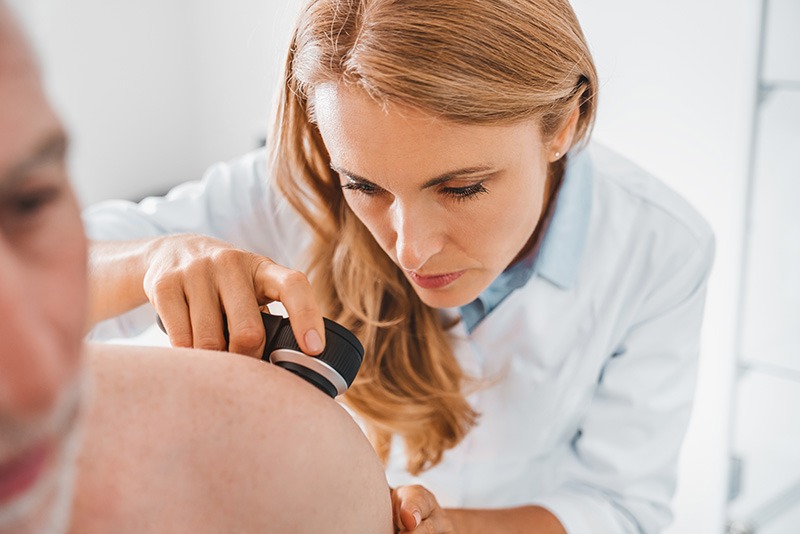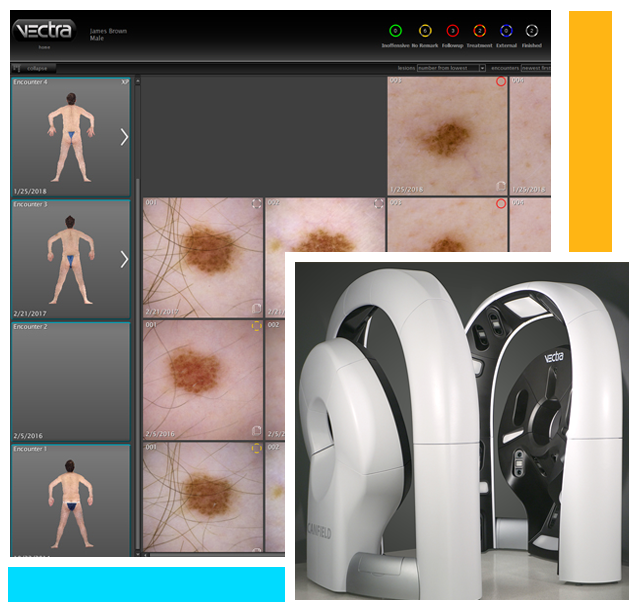
Regular assessments of moles, spots, and other changing blemishes are crucial in detecting skin cancer early. At SunLife, we are frequently asked about the difference between a skin check and mole mapping. In this article, we provide a detailed explanation to help you understand the distinction between these two important procedures.
What is Mole Mapping?
Mole mapping is the process of taking a series of photographs to document or ‘map’ the skin, recording the location and condition of every mole and skin lesion over the entire body. These photos then become a point of reference for comparison, to enhance the ability to detect changing moles or lesions. Traditional Mole Mapping has now been largely superseded by modern Total Body Photography, with more detailed imaging to see both new and changing moles.
Patients of SunLife have access to the latest in mole mapping innovation – Total Body Photography with Vectra 3D imaging. Rather than taking multiple photos, this state of the art computer takes a photo of the entire body in one flash, enabling the meticulous mapping of every mole and lesion on your body on a 3D avatar.
Not only can your skin cancer doctor assess this information, the Vectra system also uses computer recognition to help compare images and mole changes over time. It is focused on diagnosing melanoma.
What is a Skin Check?
At SunLife, a skin check is a detailed, full-body skin cancer examination performed by one of our trained, experienced and caring skin cancer doctors. This examination includes a thorough assessment from head to toe, including the scalp and under the fingernails. The primary purpose of a skin check is to identify and diagnose the presence of pre-cancerous and cancerous spots.
During the examination, any suspicious spots are photographed using a dermatoscope, a specialised device that removes skin reflection and magnifies. This allows us to see into the upper layers of the skin and see patterns that can identify skin cancer. This can achieve a more accurate skin cancer diagnosis while minimising the need for unnecessary biopsies or excisions.
These individual high-resolution images are then saved to your patient file allowing for monitoring of any changes over time. Additionally, your doctor will provide you with a personalised skin cancer risk assessment, prevention advice and an ongoing skin cancer management plan.
Choosing Between a Skin Check and Mole Mapping:
While a skin check is strongly recommended for all at-risk patients to assess and diagnose present skin concerns, many individuals opt for both a skin check and mole mapping to enhance early skin cancer detection over time.
This combination is particularly recommended for high-risk individuals including those with a high mole count, family history of melanoma and high UV exposure. If you are uncertain whether mole mapping using total body photography is of benefit to you, our experienced skin cancer doctors can provide guidance during a skin check appointment.
Vigilance in Skin Cancer Detection
Understanding the distinction between a skin check and mole mapping is important when it comes to being proactive with skin cancer detection. Regular skin checks are recommended at least once a year for all patients. This allows for the assessment and diagnosis of any existing skin concerns.
By combining the thoroughness of a skin check with the advanced technology of 3D Total Body Photography mole mapping, we provide the highest level of care and early detection for our patients.
To learn more about skin checks and Total Body Photography or to schedule a consultation at SunLife, contact our clinic today. Our dedicated doctors with years of experience detecting, diagnosing and treating skin cancer operate at the highest industry standards to ensure the safety and comfort of all our patients. We look forward to providing you with the peace of mind you deserve.


